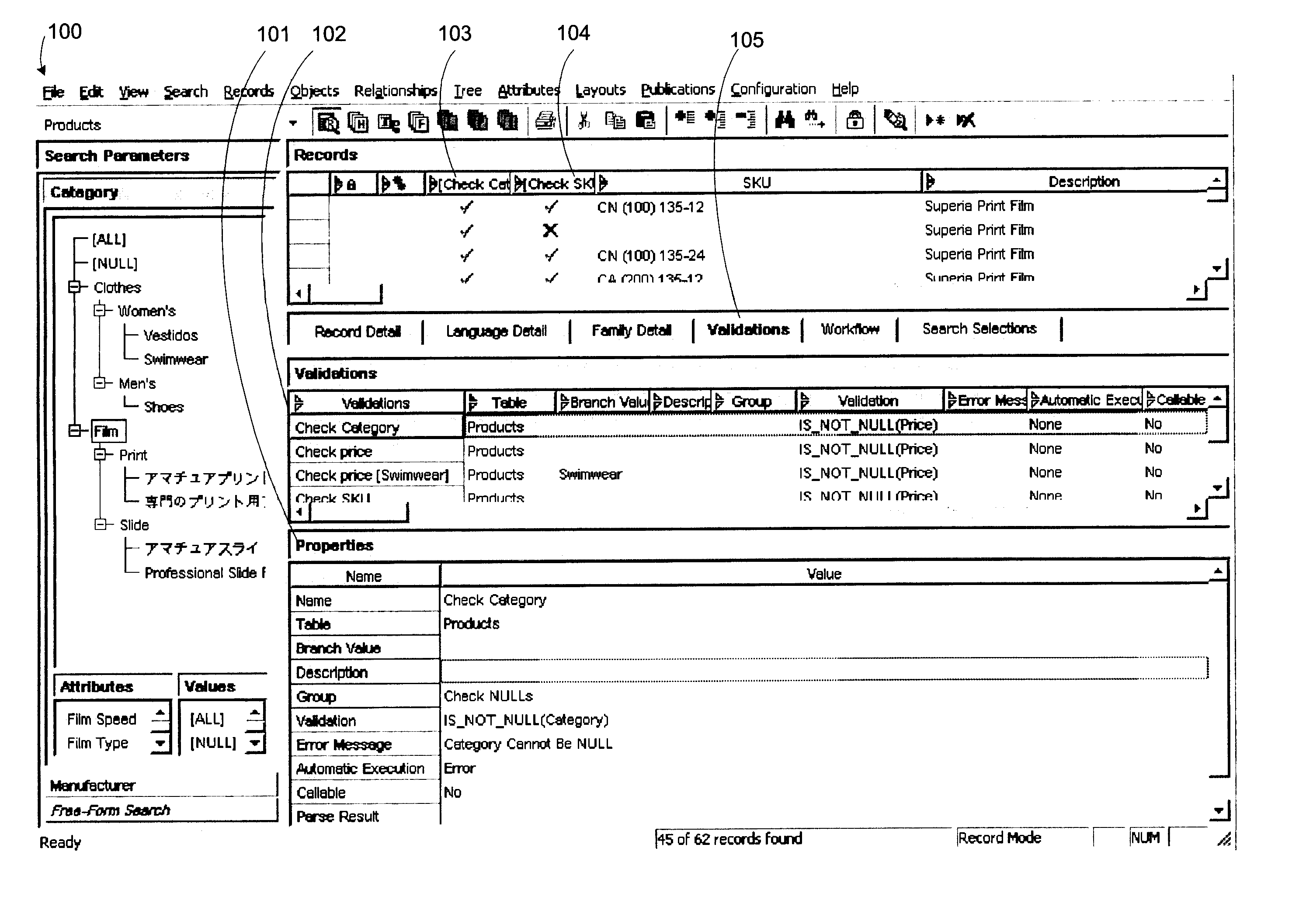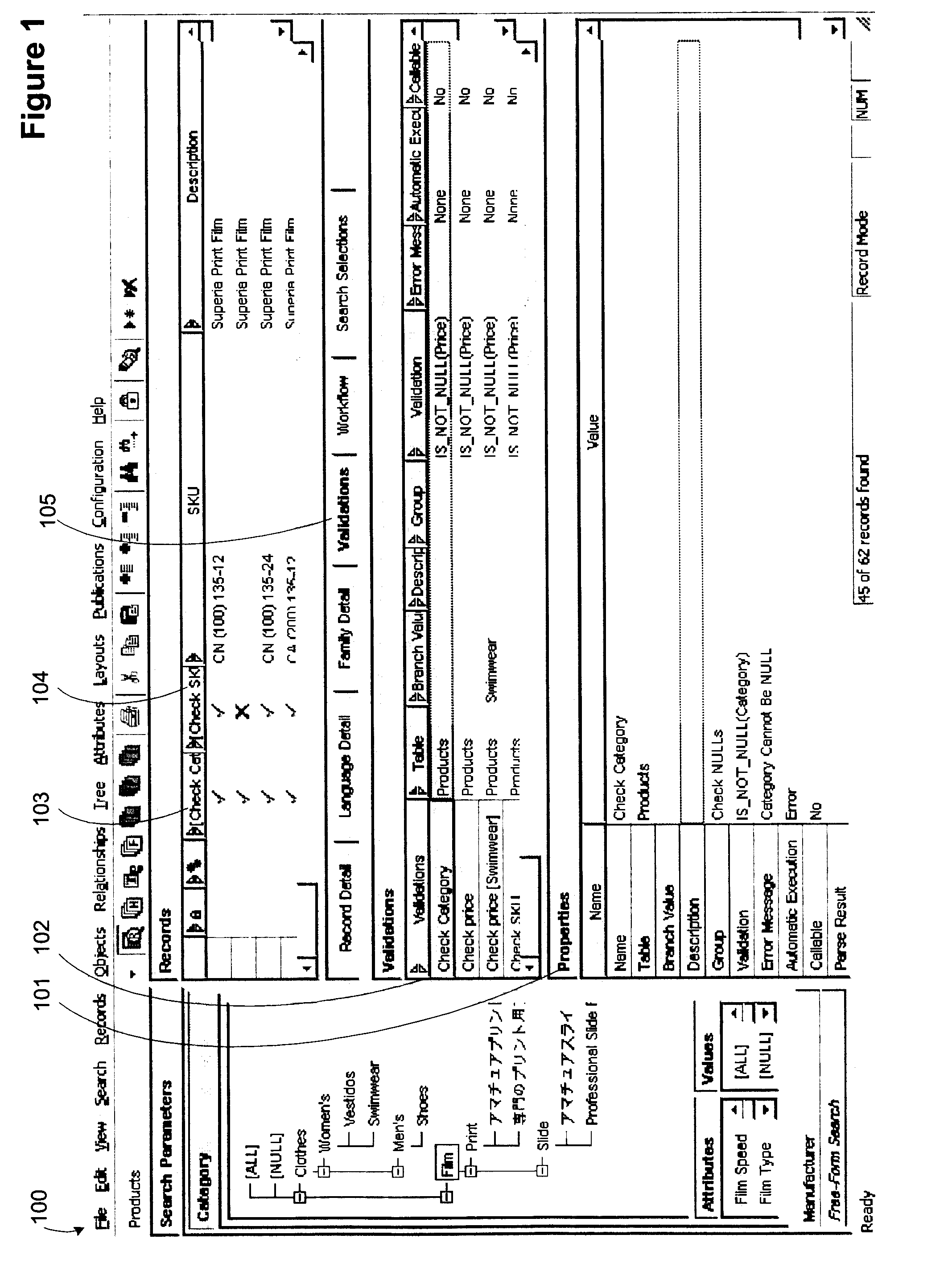[0008] One or more embodiments of the invention comprise an interface that assists in constructing validation expressions by providing tokenized pick lists of field names and field values. In addition, a measurement builder for entering legal tokenized measurement values and dimensions with applicable units of measure further aides in the construction process. The interface also allows for conditionally branching on field values and attribute values including categories, families and audience values, names and levels. Embodiments of the invention allow knowledgeable users to rapidly create expressions to ensure that the legal
syntax and
semantics of an expression are not violated while providing the user with pick lists and measurement or dimension values within legal ranges and with applicable units of measure. Allowing validations to
branch based on an audience values / names / levels and family or
category specific field or attribute values allows a specific validation to be performed based the underlying data.
[0009] As utilized in the context of this disclosure, “fields” are associated with all records of the main data table, i.e., all records in the main data table comprise the same fields. “Attributes” are quantities that are associated with subsets of the main data table, i.e., specific to a given category which is a field in the main data table. Attributes do not reside in the main data table. Therefore, based on the value of a category field or other any other fields of the main data table, attributes may be associated with a subset of the records of the main data table. An “audience” may be thought of as a third dimension added on top of the main data table and attribute tables so that audiences that comprise different languages, regions, regulatory zones, or any other
subdivision based on any quantity may be used to form a hierarchy upon which to find data for fields or attributes that are not found on a given audience level in the
database. Audiences can be as complex as required to support the number of targets and number of languages, regions, religions, cultures or any other division conceivable. An audience hierarchy may be formed from the viewpoint of a given audience to take
advantage of the entries of most of the other fields of another audience, so that multiple audiences that are similar may be readily supported. For example, to support a catalog targeting the United Kingdom, the word “colour” in a field or attribute would simply need to have the word “color” replaced in order to support the same catalog targeted at the United States. By making one audience inherit from another, any entries not found in one audience are automatically obtained from another audience. This increases the integrity of the data and allows for one edit to alter the output for as many audiences as use a piece of data. “Lookup tables” are used in order to place a text object for example in one place in the
database and which are referenced by a smaller quantity, i.e., a reference identifier or key into the
lookup table. Lookup tables save large amounts of space and provide benefits with regards to
data integrity since a change of a value in a
lookup table may be made once instead of in a million records for example.
[0010] A validation expression can define intra-
record tests and inter-
record tests with unlimited complexity. Specifically, validation expressions can reference fields and attributes (using any table including the main table, lookup tables and non-lookup sub-tables), perform arithmetic, string, and
logical operations, call built-in functions, and even reference other previously defined validations. A validation expression is token-based, so that a user is not required to manually type field, attribute, operator, function, dimension or unit names. Instead, the tokens to be used in the expression are selected from drop-down lists, reducing the potential for
typing error. For example, pre-defined dimensions and units of measure allow for tokenized input of these elements without requiring manual
typing of the desired dimension or unit of measure. One or more embodiments of the invention optionally allow for the user to type in characters that automatically limit the values presented in pick lists, thereby narrowing the possible selections.
[0017] Using a
conditional branch as a
search filter returns different records based on the records selected for search. By selecting different records and maintaining the same search filters, entirely different search results may appear. For example a
conditional branch that branches on a category may have a first child
branch for category “shoes” that searches for shoes of a given size and a second child branch for category “swimsuits” that searches for swimsuits of a given pattern. When applied to a
drill down search on category, manufacturer or free-form or any combination thereof, the final results in this case would depend on the category being searched on. It does not make sense to search for patterns associated with shoes. The ability to conditionally branch validations on family values and on audience names, levels and values showing through certain fields provides extreme flexibility in searching for data.
 Login to View More
Login to View More  Login to View More
Login to View More 


